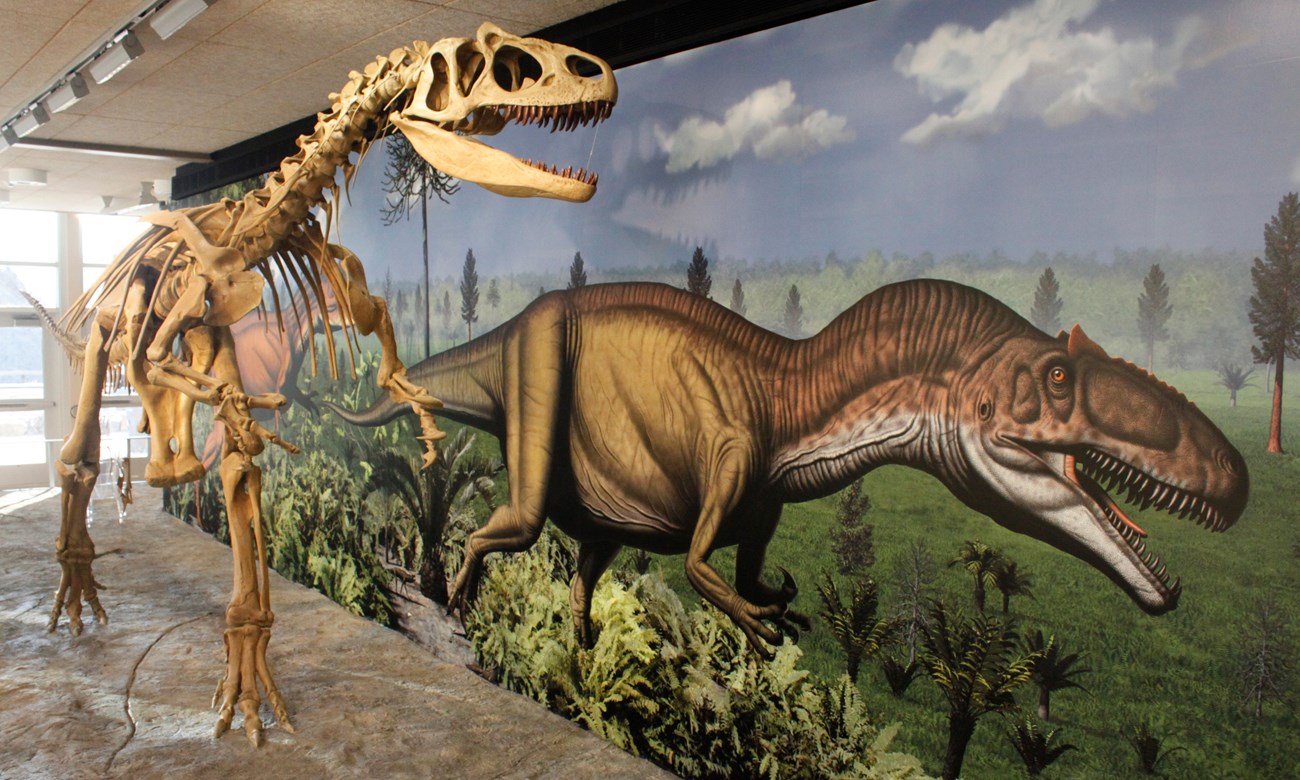
NPS image.
Introduction
What makes a dinosaur a dinosaur? There are several ways of answering this question, some more accurate (and useful!) than others. A popular but very inaccurate definition calls any big extinct reptile-like animal a dinosaur. This would include everything from the sail-backed mammal cousin Dimetrodon, to marine reptiles, to flying pterosaurs! Sometimes even crocodiles are included. These animals lived in the Age of Dinosaurs, but were not dinosaurs.
Defining Dinosaurs
A more handy general definition would go something like this: Dinosaurs are extinct animals with upright limbs that lived on land during the Mesozoic Era (252 to 66 million years ago). This would basically capture how paleontologists long thought about dinosaurs. With a few exceptions (some pesky early crocodile relatives with upright limbs, for example), it still works if you’re thinking about “classic” dinosaurs: Brontosaurus, Stegosaurus, Triceratops, Tyrannosaurus, etc.
A Note About Birds
Our definition above does leave out something very important: It is now known that birds evolved from small carnivorous dinosaurs during the Jurassic. Therefore, dinosaurs are not extinct, they are not confined to the land, and we would not think of many true dinosaurs as “reptiles”. Because modern birds are so distinct from reptiles, and became very specialized for flight early on, many paleontologists find it useful to distinguish birds from the other dinosaurs. If you go through the scientific literature, you might see something like “non-avian dinosaur”. This just means the scientist is excluding birds.
Science at Work—Refining Our Understanding
The general definition above is based on detailed anatomical studies that showed what kinds of animals could be considered dinosaurs. Dinosauria was originally described as a group by Sir Richard Owen in 1841 based on the fragmentary fossils of three British dinosaurs: Iguanodon, Megalosaurus, and Hylaeosaurus (the one everyone forgets). He linked them by various anatomical characteristics, most of which are now known to be more widely distributed among reptiles or are only found in some dinosaurs. It was a start, though, and as more and better fossils were found, scientists refined the definition of “dinosaur”. Redefinition is part of how science works. As we learn more about something, we may find out that what we used to think isn’t quite right, so we make changes as necessary. For example, when Iguanodon and Megalosaurus were first found, only a few bones were known, and they were thought to be four-footed lizard-like animals. More complete fossils showed that they walked on two legs.
Additional Clues from Bones and Teeth
It’s actually hard to define dinosaurs just on a few features of their anatomy. It’s easy enough in most cases to tell if a fossil belonged to a dinosaur, as long as it’s similar to a known dinosaur. However, when we’re thinking of defining dinosaurs as a whole, or trying to determine if a fossil from the Triassic came from a dinosaur (when dinosaurs were only one of many kinds of reptile), it’s more difficult. Because dinosaur skeletons varied so much, even without birds, there are often exceptions to a given anatomical feature. Not surprisingly, fossils of Triassic dinosaur cousins often look very similar to fossils of true early dinosaurs, so what we might think is a defining feature of a dinosaur may turn out to be present in their nearest relatives, too. Also, as we have learned more about other fossil reptiles, we’ve found that some groups had occasional dinosaur-like features. For example, in the Triassic there were non-dinosaurian groups that looked like ostrich-mimics or bigger theropods, or had teeth very much like simple herbivorous dinosaur teeth, so that isolated bones and teeth might be confused for dinosaur fossils. Therefore, it is important to look at more than just one or two features, especially with Triassic reptiles.
Dinosauria Family Tree
Another way of thinking about the question is to look at evolutionary relationships. We can take a few species that everyone agrees are dinosaurs (say, Diplodocus carnegii, Triceratops horridus, and the house sparrow Passer domesticus, so we get all three main lineages), and define Dinosauria as the group that includes all of the animals descended from the most recent common ancestor of those three species. The way we figure out if an animal would be on the inside or the outside of this group is to compare multiple anatomical features with dinosaurs and non-dinosaurs. This is much easier to do now by using computers, which can run calculations comparing the presence or absence of hundreds of features among dozens of species.
Site Index and Credits
Age of Dinosaurs (2021)
Text by Justin Tweet (AGI). Contributors: Vincent Santucci (GRD), Adam Marsh (PEFO), ReBecca Hunt-Foster (DINO), Don Corrick (BIBE). Project Lead / Web Development, Jim Wood (GRD).
References
-
Tweet, J.S. and V.L. Santucci. 2018. An Inventory of Non-Avian Dinosaurs from National Park Service Areas. in Lucas, S.G. and Sullivan, R.M., (eds.), Fossil Record 6. New Mexico Museum of Natural History and Science Bulletin 79: 703-730. https://irma.nps.gov/DataStore/Reference/Profile/2257153
-
Santucci, V.L., A. Marsh, W. Parker, D. Chure, and D. Corrick, 2018. “Age of Reptiles”: Uncovering the Mesozoic Fossil Record in three Intermountain national parks. IMR Crossroads. Spring 2018, p. 4-11. https://irma.nps.gov/DataStore/Reference/Profile/2253529
Last updated: July 8, 2022
